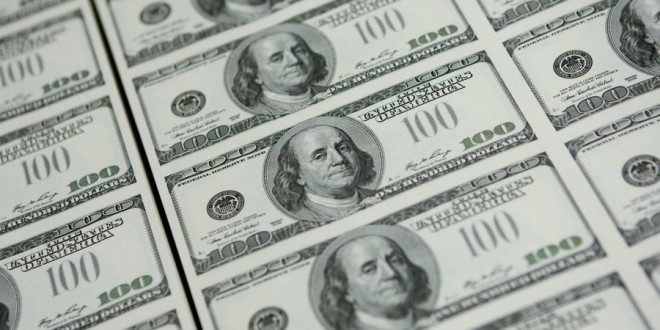Many of us have seen television medical dramas where the patient’s heart has stopped. The doctor grabs two paddles connected up to a machine, applies them to the chest, yells “clear” so everyone backs away, and shoots a jolt of electricity into the patient. Invariably, this is repeated a couple of times and the juice is turned up for heightened dramatic effect. The camera switches to the heart monitor, and the trace on the screen goes from flat-line back into sinus rhythm. Relief and high-fives all ‘round! Next day the patient, now hale and hearty, thanks the doctor. One of my brothers is a medical doctor, and he tells me this is largely theatre. In the majority of cases, those patients whose hearts have stopped can be brought back from the brink with a defibrillator, but the underlying condition is usually so grave that the procedure often has to be repeated again and again. The prognosis for long-term survival is not very good.
Can the same be said for the American economy?
Some gold bugs are disappointed the price of gold didn’t spike up to the $400-$500 range in wake of the terror attacks. In fact, the lack of a spike upward again fed the “barbarous relicno longer important” arguments that we have heard ad nauseam. Others said that this behaviour was proof the economy is strong. On Friday, Sept. 24th, there were 18 new highs and 784 new lows on the NYSE. Significantly, 8 of the new highs were gold shares, but this went largely unreported and ignored.
Gold is not spiking up because investors are waiting to see if this is a sucker’s rally or not. Many – but fewer this time – are beguiled into believing renewed claims the long awaited economic recovery is right around the corner. Most of the deceived really believe that the precipitous drop the markets took after the terror attacks was an unprecedented buying opportunity. Abby Joseph Cohen, head cheerleader of Goldman Sachs, told everyone last Monday to increase their portfolio from 70% to 75% weighting in shares. This was trumpeted far and wide. By Wednesday’s close, a mere 2 days later, seven of the Nasdaq 100 fell below $1 per share, where technically they are required to be booted from the index. If a company stays down for more than a month it is delisted from the exchange (they changed the rules the 27th Sept., to avoid this.) One company in the Nasdaq 100 actually filed for bankruptcy! Even through the great Monday rally, NYSE and Nasdaq “new 52 week lows” exceeded “new highs” by a wide margin. Yet every down day the shills say “we have put in a new bottom” and tell us to “buy on the dips”. Too many people still believe this guff for gold to make big moves. The networks have precious few advertising dollars as it is. The analyst who says “get out of the market and into bullion” won’t be asked back – the Brown & Co. aardvark (or whatever it is that appears on those CNBC adverts) would bite them.
Remember all the B2B business models? “Just-in-time shipping” to avoid warehousing charges and inventory costs? All these people have come unstuck with the hiatus in air travel and now the loss in routes. My travel agent is telling me to cash in all my frequent flyer points before certain airlines declare bankruptcy. A short while ago, if industry had attempted the massive job cuts we have recently witnessed there would be wildcat strikes everywhere. Unions know how dire the situation really is.
In a Reuters’ report of September 26th, the IMF’s World Economic Outlook projected 2001 growth of 2.6%. The lowest rate since 1993. Their figure doesn’t even factor in the September 11th attacks. The IMF is now saying that the WORLD may be headed into recession. Isn’t it funny how for the last 6 months we have been hearing “might be going into recession” or “significant delay to the U.S. recovery”. Recession has been here for months. Everyone has local economic indicators. Here are three of mine:
I noticed last week at the local multiplex cinema that the specialty coffee bar is gone – just a conspicuous gap where it used to be. The person who served up the coffee is gone too and the cinema is almost empty. At the bookstore in the mall – one of those big sprawling things – 3 empty spaces where cash registers used to be. The tills are gone, as are the cashiers. My other brother makes custom golf clubs. I stopped in to visit him yesterday. In the industrial/commercial park where he has his shop almost all the unit tenants are gone. Old newspapers in the windows. I’m sure that if you think about it you can call up a dozen of your own examples. Where do all these unemployed people go?
I have been rereading “When Money Dies – the Nightmare of the Weimar Collapse” by Adam Fergusson, which is all about the post-WWI inflation that hit Germany. I last read this book about 20 years ago. What a masterpiece! Sadly, it is now out of print. Here’s an interesting excerpt:
Those with foreign currency, becoming easily the most acceptable paper medium, had the greatest scope for finding bargains. The power of the dollar, in particular, far exceeded its nominal rate of exchange. Finding himself with a single dollar bill early in 1923, von der Osten got hold of six friends and went to Berlin one evening determined to blow the lot; but early the next morning, long after dinner, and many nightclubs later they still had change in their pockets. There were stories of Americans in the greatest difficulties in Berlin because no one had enough marks to change a five-dollar bill: of others who ran up accounts (to be paid off later in depreciated currency) on the strength of even bigger foreign notes which, after meals or services had been obtained, could not be changed; and of foreign students who bought up whole rows of houses out of their allowances.
There were stories of shoppers who found that thieves had stolen the baskets and suitcases in which they carried their money, leaving the money itself on the ground; and of life supported by selling every day or so a single tiny link from a long gold crucifix chain. There were stories (many of them, as the summer wore on and as exchange rates altered several times a day) of restaurant meals which cost more when the bills came than when they were ordered. A 5,000 mark cup of coffee would cost 8,000 marks by the time it was drunk.
Economists tend to think of the inflation that rocked Germany from 1919-1923 as some sort of unrepeatable aberration. In a desk drawer I have a collection of paper – it used to be paper money, now it’s just paper. Like the 10,000 Australes (Argentina) from my trip in 1991, the 1000 Russian rouble notes from my 1995 trip that are now demonitised, the Brazilian 500 Cruzados Novos notes overstamped “Cruzeiros” but now useless anyway, the 10,000 Ecuadorian Sucres notes, demonitised only last year. I also have some near-paper, like the 5 Venezuelan Bolivars and 2 Kazakh Tenge, both worth a fraction of a U.S. cent. All this paper looks imposing with their artistic engravings and patriotic mottos. All of it worthless.
I also found a receipt in the same drawer for 2 Australian 1 oz gold nugget coins dated September 9, 1988 from the Australia and New Zealand Bank Group Limited in Brisbane. I paid $1,156.64 AUS for those coins. The same coins today cost $1,234.98 AUS. Sure, the cash doesn’t buy the same groceries, but the gold hasn’t become worthless, and that’s my point. I know that another 13 years from now gold will still be valuable. I can’t say the same for the paper. When I bought the coins in 1988 it was not to cash them in at some later date for great profit, it was to preserve wealth. I still have them tucked away. A welcome bonus of course comes when demand for gold exceeds supply by so much that it has to be had at almost any price. In the above excerpt from “When Money Dies”, mentally substitute “1 gram of gold” for “dollar bill” and you’ll get the picture.
“Government stimulus”, “injected liquidity”, “tax holidays”, “tax rebates”, “government bailouts” are all inflationary. Some misguided soul on CNBC said yesterday morning that U.S. fiscal engineering “is a case of moving around tax revenues”. Sorry to tell you, but this money doesn’t come from hard-working Americans, – it is created out of thin air. The ballooning of the U.S. money supply is there for all to see, printed every week in the Wall Street Journal. The U.S. government is destroying what has been regarded as the world’s only safe haven currency – the thing stuffing Russian and Latin American mattresses. The dollar is only at historic highs against the Rand, and the Aussie and Canadian dollars because their economies are perceived to be in even worse shape. Will we eventually see hyperinflation in America? If the government continues, and even steps up the use of the printing press to inflate away the problems of the economy, it is inevitable. This is the path of least resistance, given the recent bubble history of the markets. In Germany in 1922-23, the stock market which previously was in a slump, crazily took off as people turned their currency into shares in misguided attempts to preserve wealth as the currency declined. Shares though soon couldn’t keep up with the rising value of hard assets. Eventually, the entire market capitalization of Daimler was exceeded by the price of a few hundred of their cars. Government bailed out essential industry that had its infrastructure disrupted by war. First were the railroads. The bailout soon became universal, as nothing was allowed to fail. The inflationary devaluation of the mark made German goods so cheap that manufacturers couldn’t keep up with foreign demand. At the beginning of the hyperinflation, before internal markets collapsed, employment was nearly 100% of the workforce. On the face of it, this looked great, but wages hardly bought anything. Only competitive beggar-my-neighbour devaluations by governments can restore markets for goods in a WORLDWIDE recession.
What happens to stock markets in the near term is predictable. It will be kicked in the teeth when poor 3Q earnings reports come out. Most Americans no longer have savings to revive the market. Whatever happens now – and this is the clincher – the future will be bullish for gold. Financial Armageddon may not be imminent, but it’s a good idea to have some gold handy in the sock drawer just in case. The forecasts say we are in for continuing “middling down” recession, more layoffs and abysmal corporate earnings. Depression must be avoided at all costs, so expect more “applying of the paddles” in the form of interest rate cuts, forgiving of debt, and fiscal stimulus packages. The patient may be revived, indeed linger on for some time yet, but the eventual demise will be signalled by a headlong flight out of the dollar. For the first time in modern history there will be no safe haven currency. Only gold.
We may not see a $100 up day for gold in the near future, but the momentum is there and it is building.
*****
Straight Talk on Mining is provided for information purposes only. Nothing herein is to be construed as a recommendation to buy or to sell any particular security or financial instrument. Nothing herein is to be construed as a recommendation to engage in any particular investment strategy or trading strategy.
The investments discussed herein may be unsuitable for investors depending on their specific investment objectives, financial situation, and risk tolerance. Private investors should obtain the advice of a qualified financial advisor before entering into any transaction.
Straight Talk on Mining is based on information that is generally available to the public. The sources used are believed to be reliable, but because the information and data that they provide are beyond my control, no representation is made that it is complete or accurate. References to other publications and direct links to external Internet sites are sometimes given. The inclusion of any publication, organization or Internet site herein does not imply any endorsement. Straight Talk on Mining has no control over the content of any Internet site that you may reach through links that are provided, nor can their truth, accuracy, or completeness be vouched for.
Straight Talk on Mining is not a financial services company nor is it affiliated with any financial service company in any jurisdiction.
The author/publisher, Dr. Keith M. Barron, is not a qualified financial advisor and is not acting as such in this publication. The accuracy of any legal term or definitions used herein should be verified with your legal advisor or the appropriate government agency.
 Straight Talk On Mining Insights on mining from economic geologist Dr. Keith Barron.
Straight Talk On Mining Insights on mining from economic geologist Dr. Keith Barron.




